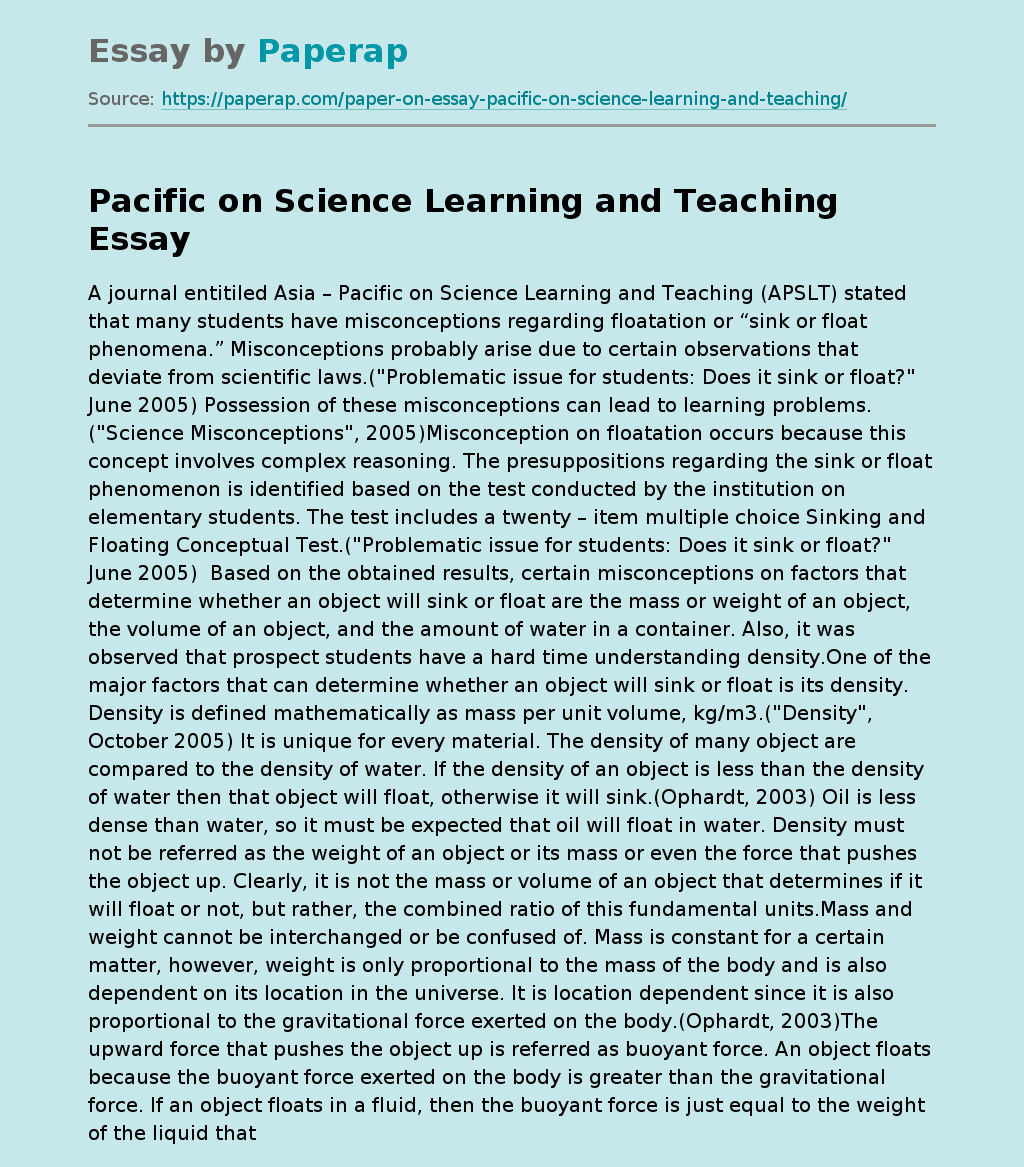A journal entitiled Asia – Pacific on Science Learning and Teaching (APSLT) stated that many students have misconceptions regarding floatation or “sink or float phenomena.” Misconceptions probably arise due to certain observations that deviate from scientific laws.(“Problematic issue for students: Does it sink or float?” June 2005) Possession of these misconceptions can lead to learning problems.(“Science Misconceptions”, 2005)Misconception on floatation occurs because this concept involves complex reasoning. The presuppositions regarding the sink or float phenomenon is identified based on the test conducted by the institution on elementary students.
The test includes a twenty – item multiple choice Sinking and Floating Conceptual Test.(“Problematic issue for students: Does it sink or float?” June 2005) Based on the obtained results, certain misconceptions on factors that determine whether an object will sink or float are the mass or weight of an object, the volume of an object, and the amount of water in a container. Also, it was observed that prospect students have a hard time understanding density.
One of the major factors that can determine whether an object will sink or float is its density. Density is defined mathematically as mass per unit volume, kg/m3.(“Density”, October 2005) It is unique for every material.
The density of many object are compared to the density of water. If the density of an object is less than the density of water then that object will float, otherwise it will sink.(Ophardt, 2003) Oil is less dense than water, so it must be expected that oil will float in water.
Density must not be referred as the weight of an object or its mass or even the force that pushes the object up. Clearly, it is not the mass or volume of an object that determines if it will float or not, but rather, the combined ratio of this fundamental units.Mass and weight cannot be interchanged or be confused of. Mass is constant for a certain matter, however, weight is only proportional to the mass of the body and is also dependent on its location in the universe. It is location dependent since it is also proportional to the gravitational force exerted on the body.(Ophardt, 2003)The upward force that pushes the object up is referred as buoyant force. An object floats because the buoyant force exerted on the body is greater than the gravitational force. If an object floats in a fluid, then the buoyant force is just equal to the weight of the liquid that is displaced. This principle is formulated Archimedes. However, if a certain object sinks in water, then the weight of the object is equal to the buoyant force exerted on it.(Kurtus, 2003) It can be said that a stuffed animal will float when immersed in water because its density is less than the density of water. Same reasoning can be used to explain why styrofoam can float in water. Lastly, a cardboard will not float in water due to its ability to absorb water.To avoid the pre-said misconceptions certain conditions must be achieved.
First, concepts such as density, mass, weight must be clearly explained.(Kurtus, 2003) Experiments must be employed. This experiment must allow one to determine whether an object will float or not accompanied with proper scientific explanations. This experiment must allow one to determine the characteristics of an object that floats and objects that sink. One must develop the thinking that it is not only the weight that determines if an object will sink in a fluid.(“Sink or Float?” 2006) Also, different factors that determine whether an object will sink or float must carefully be studied.
Pacific on Science Learning and Teaching. (2019, Jun 20). Retrieved from https://paperap.com/paper-on-essay-pacific-on-science-learning-and-teaching/

